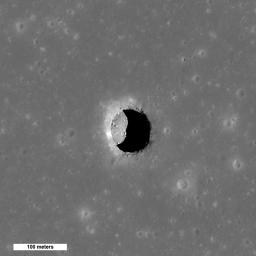
|
New Views of Lunar Pits
- Click the image above for a larger view
- Full-Res JPEG (800 x 800) (52.9 kB)
- Full-Res TIFF (800 x 800) (640.9 kB)
Caption:
Spectacular high Sun view of the Mare Tranquillitatis pit crater revealing boulders on an otherwise smooth floor. Image is 400 meters wide, north is up, NAC M126710873R.
When the Sun is well overhead, the floor of the Mare Tranquillitatis pit is illuminated. With an incidence angle of 26.5° and a shadow of 55 meters (180 feet), scientists can estimate the depth to be a bit over 100 meters (328 feet). That estimate is from the edge of the shadow, which begins a slightly downslope from the gradual margin of the pits. When measured from the level of the surrounding mare plain, the depth of the pit is even greater. Compare this depth to the width, which ranges from 100 to 115 meters (328 to 377 feet) across the sharp precipice.
Background Info:
NASA's Goddard Space Flight Center built and manages the mission for the Exploration Systems Mission Directorate at NASA Headquarters in Washington. The Lunar Reconnaissance Orbiter Camera was designed to acquire data for landing site certification and to conduct polar illumination studies and global mapping. Operated by Arizona State University, LROC consists of a pair of narrow-angle cameras (NAC) and a single wide-angle camera (WAC). The mission is expected to return over 70 terabytes of image data.
Cataloging Keywords:
| Name | Value | Additional Values |
|---|---|---|
| Target | Moon | |
| System | Earth | |
| Target Type | Satellite | |
| Mission | Lunar Reconnaissance Orbiter (LRO) | |
| Instrument Host | Lunar Reconnaissance Orbiter | |
| Host Type | Orbiter | |
| Instrument | Lunar Reconnaissance Orbiter Camera (WAC) | |
| Detector | Narrow Angle Camera (NAC), Wide Angle Camera (WAC) | |
| Extra Keywords | Crater, Grayscale, Shadow | |
| Acquisition Date | ||
| Release Date | 2010-09-14 | |
| Date in Caption | ||
| Image Credit | NASA/GSFC/Arizona State University | |
| Source | photojournal.jpl.nasa.gov/catalog/PIA13518 | |
| Identifier | PIA13518 | |
